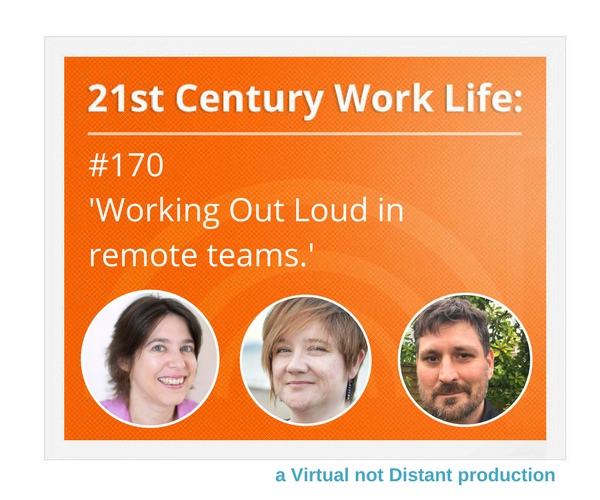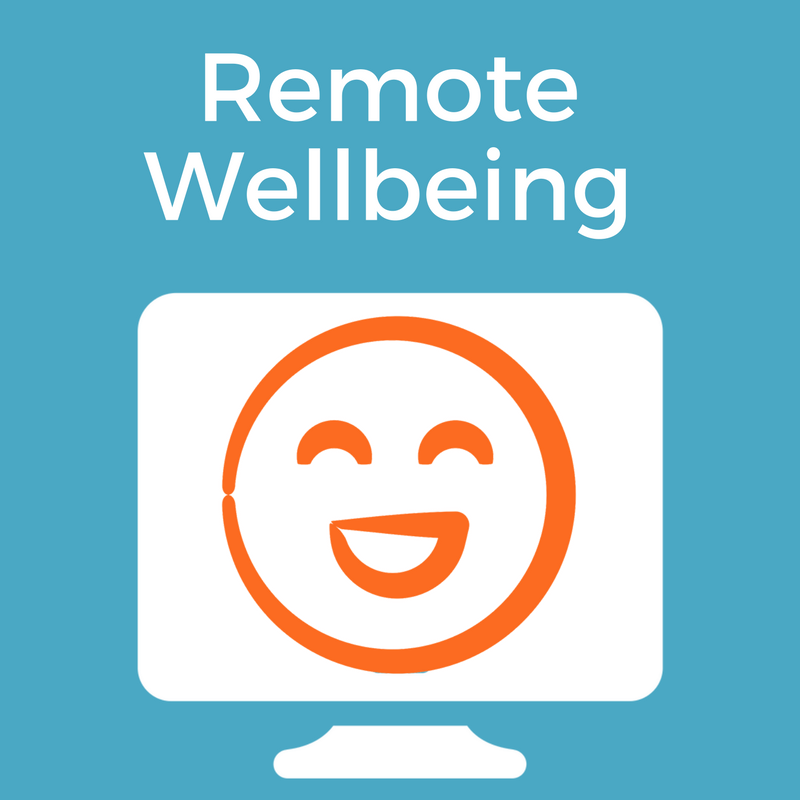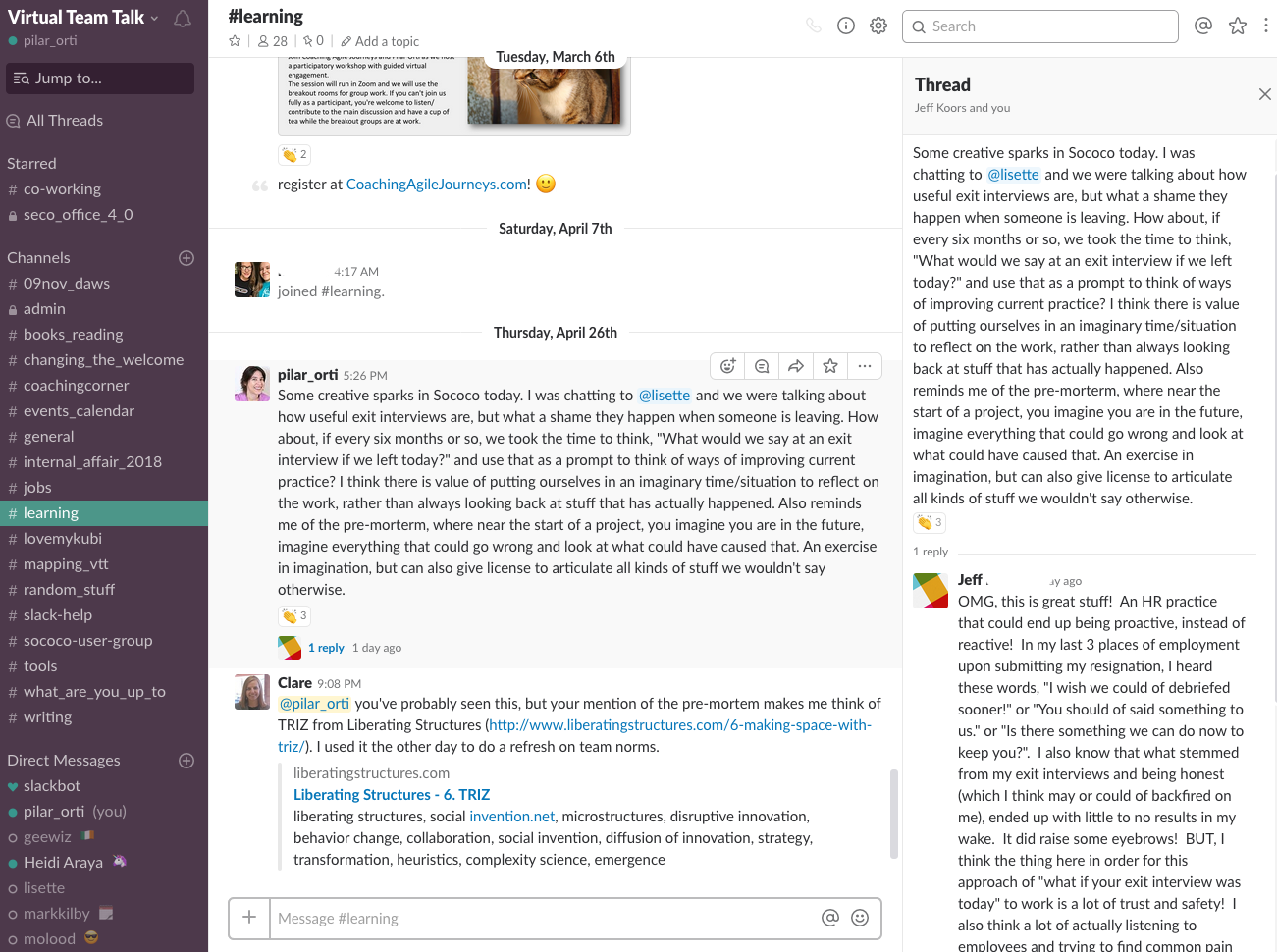WLP170: Working Out Loud in Remote Teams
We have a packed show for you today, looking at strategies and tactics for successfully “working out loud” – We hope you’re enjoying our new-style podcast format, we’d love to hear what you think, do tweet us @VirtualTeamW0rk, or just pay us a visit at Virtual Not Distant .
And don’t forget, booking is open for our great FREE webinar in June, in collaboration with Trainingzone and GoToMeeting - helping your team transition to remote, and helping you as a team leader to transition from supervisor to ecosystem DJ or spider! All will be revealed in the webinar… So secure your space today.
And before our main interview, a point to ponder: If only we could do exit interviews before people decide to leave – maybe even instead of? We could learn so much from a ‘pre-mortem’. A great conversation took place about this in Virtual Team Talk, so do come and join us there if this kind of learning exploration interests you.
6.25 Featured interview: Jochen Lillich, Founder and CEO of Freistil IT.
Our guest today is the voice behind this thought-provoking article, "Working Out Loud Doesn’t Mean Being Noisy".
Jochen manages the distributed team at Freistil IT, who are web hosting experts, large complex sites for needing active management. So they have to find ways to share and communicate effectively and continually. They use a lot of tools, especially Slack (see below), – but needed to find ways to manage the information overload and noise. Jochen blogs to build relationships and trust, to go beyond the transactional nature of business, but internally they use more real-time ways to communicate.
Aside from daily standups, one of their most used tools is a Slack channel called DIRECT – a useful framework for any team to try out.
Jochen talks to us about being intentional about sharing on distributed teams, the fact that you need to do more of it, more consciously, than you might imagine.
Enjoy the interview and the original blog post, and if you want to learn more about how the team at Freistil work together, their operating manual is freely available here: https://runbook.freistil.it/
20.58 – Wellbeing- How do we “step away from the screen”?
It isn’t easy, because screens are everywhere. How do we unplug, in a world of 24/7 connectivity? This is not just an issue for remote workers either. We can start by being more aware of it, and how our use of screens affects us.
One strategy both Pilar and Maya use is to read on a dedicated non-backlit e-reader, but don’t forget you can email any document to it, it isn’t just for reading books). It really is worth investing in a separate device for this even if you have the apps on your tablet or phone, and you’ll notice the difference in sleep quality when using it at night particularly.
Or there is always that really strange static format of paper itself. Just from time to time, and do remember to recycle!
How do you maintain healthy screen habits, and protect your eyes and your sleep? Tweet us at @VirtualTeamW0rk #remotewellbeing
26.28 Oh NO: My teams gone remote! And our relationships will suffer if all we do is type...
This is a valid concern. Typing might be great for introverts, and sometimes it’s good to think through what you want to express first... But the lack of real-time feedback has real drawbacks. Remember we can use video and audio to add context and depth to our words, we don’t have to depersonalise all of our asynchronous conversation.
There’s evidence that emotional or controversial topics are much better received in audio than written form, and this does support the way that online comment threads and email conversations can quickly deteriorate...
Perhaps we should pick up the phone a little more often, when we’re shifting to a remote workplace. Especially if we need to have a difficult or emotion-laden conversation - it’s often far too quick and easy to fire off an email. Of course this is more challenging across time zones, but with a bit of imagination, there are solutions we can use.
Written communication is best for concrete information sharing, but not for complex or loaded issues. Which is why, as a team, you also need to communicate about communications: come up with explicit agreements about how you connect and how you have different kinds of conversation. And as a leader, be sure to model the kind of behaviour you’d like your team to adopt – including a nice smiley profile picture to accompany your instant messaging chat.
What do you think? We usually suggest you tweet or email us, but there is a phone number on our contact page :-)
33.28: Recommended tool: Slack
Slack is an instant messaging app for business collaboration, for use in closed groups and teams. It’s easy to manage, with channels for different conversations, and very granular control over notifications.
A lot of the functionality is free, and it’s straightforward to set up and use on multiple devices, from tiny teams to big communities. If you’d like to take your first steps with Slack in a safe and welcome team, and you share our passion for remote working and flexibility, check out Virtual Team Talk (link above in intro).
Maya recently discussed her journey through the evolving world of online team chat in this blog post.
And that conversation we mentioned, about working out loud in Virtual Team Talk? Here's a glimpse of how it appeared in real-time in our Slack channel:
If you like the podcast, you'll love our newsletter:





